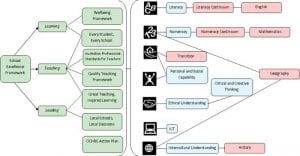(This reflection follows my readings within ETL503 Module 2)
While resource selection for teacher librarians is complex, I think it is important to vet resources based on agreed quality teaching practises across the whole teaching community and not just library collections.
Appropriate resource selection is something that will assist with ‘external validation’ from NESA, school plan formation and the NSW Department of Education ‘School Excellence Framework’ (2014) (found in NSW Department of Education (2019) Teaching and Learning).

For this reason and with suggestions from Hughes-Hassell & Mancall (2005) and the NSW Department of Education (2019), I have created a (Draft) GoogleForms questionnaire, that offers an array of resource selection decision making criteria. The questionnaire has been designed for any stakeholder to be able to answer the questions, however they may need librarian guidance for some questions such as context and philosophy. To have a look at my draft selection questionnaire, click here.
However, as noted by Hughes-Hassell & Mancall (2005) we must know the context of the school and teaching and learning philosophies of stakeholders prior to validating a resource.
While at UWS in 2006, I created a survey for families to help me identify each student’s context. For schools, this should be something created collaboratively and using information from my UWS studies, I have also created a (Draft) GoogleForms questionnaire to help schools identify their context. To have a look at my draft context questionnaire, click here.
I want to improve the context survey by reviewing a key text from my Bachelor  of Education studies at UWS. I must read the updated version (which has a massive quote from me-WOW, I’m famous!) Chapter 6 on the creation of a Situational Analysis: Farmer, Sue, et al. Programming and Planning in Early Childhood Settings, Cengage Learning Australia, (2014). ProQuest Ebook Central, http://ebookcentral.proquest.com/lib/csuau/detail.action?docID=1990997
of Education studies at UWS. I must read the updated version (which has a massive quote from me-WOW, I’m famous!) Chapter 6 on the creation of a Situational Analysis: Farmer, Sue, et al. Programming and Planning in Early Childhood Settings, Cengage Learning Australia, (2014). ProQuest Ebook Central, http://ebookcentral.proquest.com/lib/csuau/detail.action?docID=1990997
Another example of guidance might be in identifying teaching and learning philosophies. While at UWS in 2006, I realised this was an area of weakness in the degree and in teachers in general and I created a template for thinking about the various aspects of teaching and learning in order to arrive at a coherent and well-thought out philosophy, based on Posner’s (1996 & 2005) Field Experience: Methods of reflective teaching. To have a look at my draft philosophy questionnaire, click here.
References:
Hughes-Hassell, S. & Mancall, J. (2005). Collection management for youth: responding to the needs of learners [ALA Editions version]. Retrieved from http://ebookcentral.proquest.com.ezproxy.csu.edu.au/lib/csuau/detail.action?docID=289075
Posner, G. J. (1996). Field Experience: Methods of reflective teaching (4th ed.). New York: Longman. (p. 131-134);
Posner, G. J. (2005). Field Experience: a guide to reflective teaching. 6th ed. Boston: Pearson Education Inc.
Prumm, K. & Patruno, R. (2016) Elements of Learning and Achievement Manual – NSW Department of Education. Retrieved from: https://theelements.schools.nsw.gov.au/introduction-to-the-elements.html
NSW Department of Education (2019) Teaching and Learning. Retrieved from: https://education.nsw.gov.au/teaching-and-learning]
